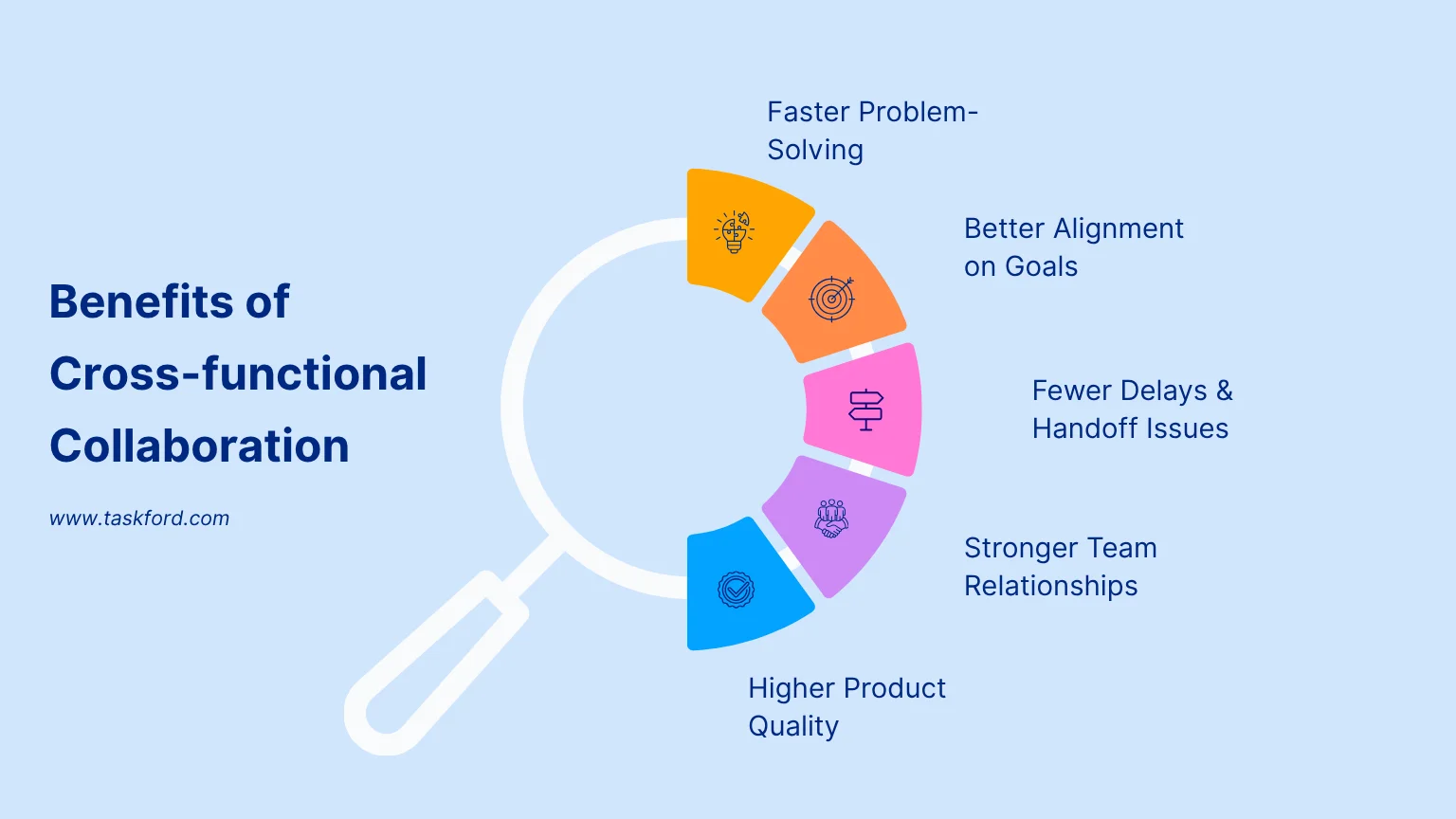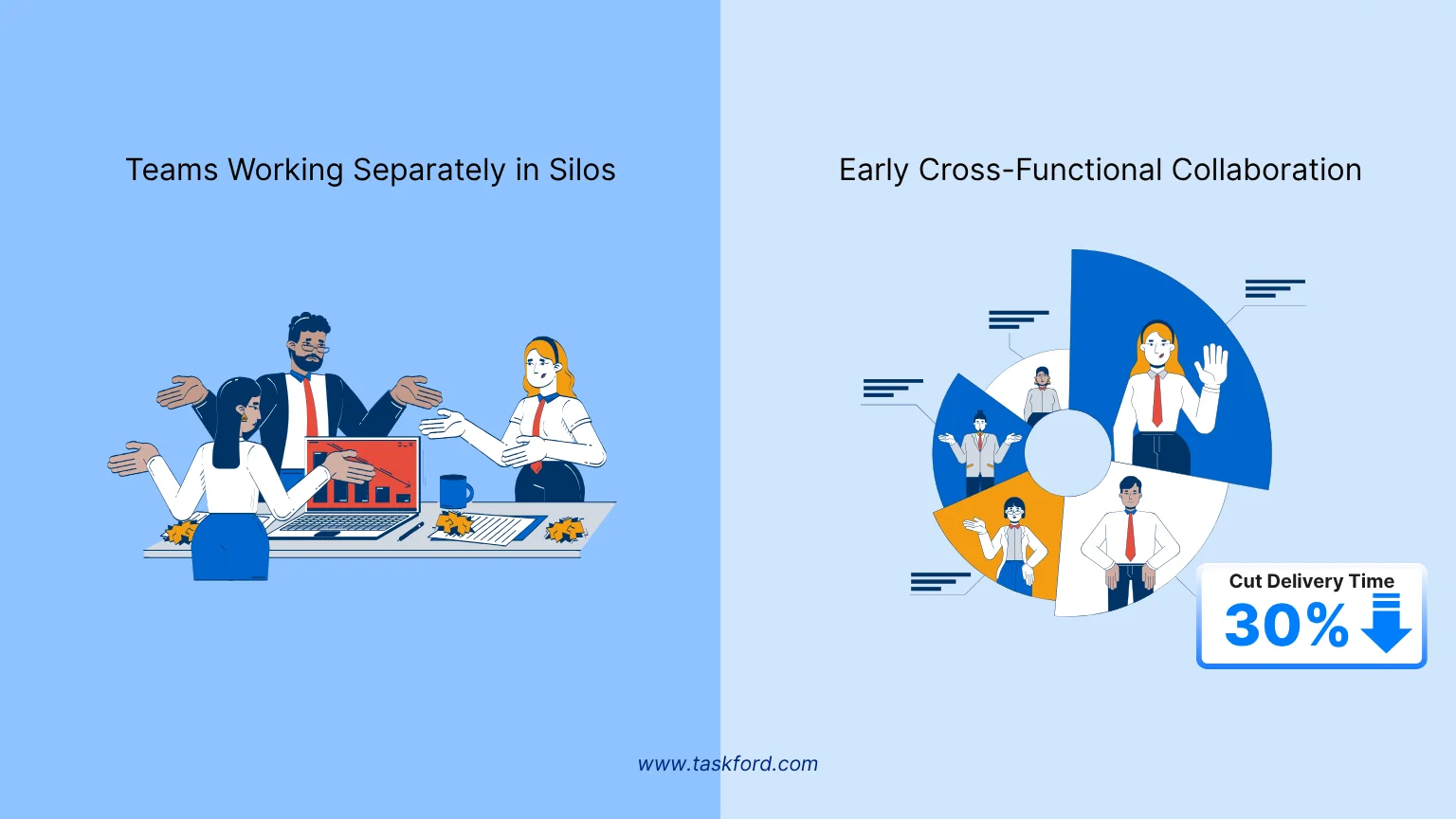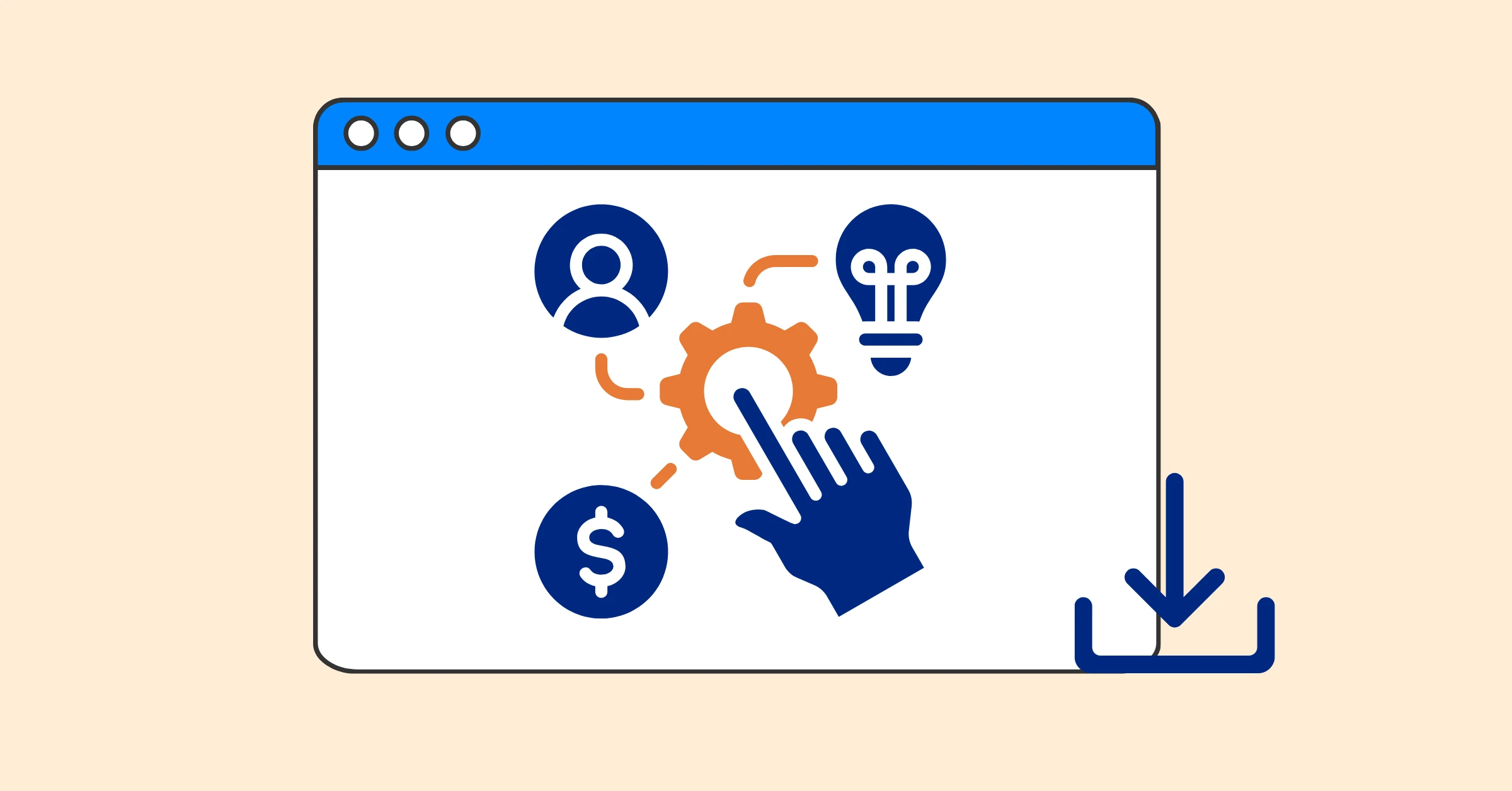How Early Cross-Functional Collaboration Cut Delivery Time by 30%
Explore how cross-functional collaboration improved alignment, built stronger teamwork, and helped a growing software team cut product delivery time by 30%.
A growing software team was finding it hard to meet product deadlines. Designs were finished on time, but development kept running into delays. Marketing waited for updates that came too late to plan launches properly. Everyone was doing their job — just not always in sync.
Things started to turn around when the team focused on cross-functional collaboration. Product, design, and engineering began working together earlier, aligning on priorities, timelines, and goals. In this use case, we’ll look at how that shift helped the company improve team alignment and cut product delivery time by 30% through better collaboration and clearer communication.
What is Cross-functional Collaboration?
Cross-functional collaboration means people from different teams, like product, design, engineering, QA, and marketing, working together toward a shared goal. Instead of passing work from one department to another, everyone stays connected throughout the process.
For managers, it’s one of the clearest examples of strong team management in action. When leaders create the right environment, clear goals, open communication, and shared ownership, collaboration starts to happen naturally. Each team understands how its work connects to others, and progress becomes smoother and more predictable.
In product development, this kind of teamwork helps ideas move faster from concept to release. Designers understand what’s technically possible, developers get early feedback on user needs, and marketing can plan launches with more accurate timelines. It’s the same mindset that drives Agile Project Management — small, connected teams working in short, focused cycles to deliver real progress.
Cross-functional collaboration is not about adding more meetings. It’s about building shared understanding. When teams see the same priorities and know how their work connects to the bigger picture, decisions come easier, communication improves, and progress feels smoother.
What are the Benefits of Cross-functional Collaboration?
When teams work closely across functions, everyone gains more visibility and context. Communication improves, decisions happen faster, and the product moves forward with fewer surprises. Here are some of the biggest benefits:

- Faster problem-solving Different skills and perspectives come together to find solutions quickly. A designer might spot a user issue early, while an engineer can suggest a simpler technical fix right away.
- Better alignment on goals Teams share the same priorities instead of chasing separate targets. Everyone understands what matters most, which reduces confusion and keeps the project on track.
- Fewer delays and handoff issues When product, design, and development stay in sync, there’s less rework and fewer last-minute changes. Workflows feel smoother, and deadlines are easier to meet.
- Stronger team relationships Collaboration builds trust. People learn to value each other’s expertise and communicate more openly. Over time, it creates a culture where teamwork feels natural.
- Higher product quality Early feedback from multiple teams helps catch problems before they grow. The result is a product that’s more user-friendly, technically sound, and ready for market sooner.
Common Cross-Functional Collaboration Challenges
Cross-functional collaboration can make product development faster and more effective, but it’s not always easy to get right. Different teams often bring their own goals, tools, and ways of working. Without clear alignment, even small missteps can slow progress and create frustration.
1. Misaligned goals and priorities
Every team looks at success from a different angle. Product managers focus on timelines, designers care about user experience, and engineers prioritize technical stability. If these goals don’t connect early, decisions get delayed, and the product vision becomes unclear.
2. Communication barriers
When updates don’t reach everyone, teams end up working with incomplete information. A design change might not make it to development in time, or a marketing launch might go live before a feature is fully ready. These small gaps often lead to avoidable rework.
3. Unclear ownership
When several teams share responsibility, it’s easy for accountability to fade. No one wants to overstep, and without clear roles, important tasks can slip through the cracks. Setting clear ownership helps teams stay focused and responsible for outcomes.
For more on how to create that balance, see our guide on Hold Employees Accountable.
4. Conflicting timelines
Each team moves at a different pace. Development may need more time for testing, while marketing works toward fixed launch dates. Without shared schedules and check-ins, teams often end up out of sync.
5. Cultural and mindset differences
Departments have different work styles and communication habits. What feels efficient to one group might feel rushed or incomplete to another. Building mutual understanding takes time but is crucial for long-term success.
Even with these challenges, teams that commit to open communication and early alignment often see big improvements. Once collaboration becomes part of how work happens—not just an extra task—progress speeds up and trust grows naturally.
Use Case: How One Team Cut Delivery Time by 30%
A growing software company was facing constant delays in product releases. Designs were often completed on time, but development ran behind schedule. Marketing couldn’t plan campaigns properly because updates arrived too late, and teams were frustrated by the lack of coordination. Everyone was working hard — just not together.
The turning point came when the company decided to improve cross-functional collaboration. Instead of handing work off from one department to another, they started bringing product, design, and engineering together early in the process. Weekly planning sessions replaced long email threads, and shared boards gave everyone visibility into progress and priorities.

By aligning early and keeping communication open, the team reduced unnecessary back-and-forth and identified blockers sooner. Decisions that used to take days were made in one meeting. Designers and developers reviewed features together before coding began, preventing rework later. Marketing joined earlier in release planning, which made launch preparation smoother.
Within three months, product delivery time dropped by 30%. More importantly, the team reported fewer last-minute fixes and a stronger sense of trust across departments. What changed wasn’t just the process — it was the mindset. Collaboration became part of how the team worked, not an afterthought.
How Early Alignment Improves Collaboration
Early alignment changes how teams work together. It gives everyone the same starting point — the same goals, priorities, and understanding of what success looks like. Instead of each department planning in isolation, everyone begins with a shared direction.
When product, design, and engineering align early, decisions come faster and with less confusion. Designers understand what’s technically possible before they go too far with concepts. Engineers can raise potential challenges before deadlines get tight. Marketing knows when features are coming, so they can plan launches in sync.
This kind of early collaboration doesn’t just save time — it prevents the small missteps that often cause the biggest delays. Issues are spotted sooner, feedback loops are shorter, and handoffs between teams feel smoother.
In this company’s case, early alignment was the turning point. Once every function started planning together from the start, the team stopped reacting to problems and started preventing them. That shift alone helped cut delivery time by nearly a third, not because they worked harder, but because they worked together.
Learn more about creating this rhythm in Sprint Planning
Best Practices for Cross-Functional Collaboration
Good collaboration doesn’t happen overnight. It takes shared goals, clear communication, and mutual respect. Here are five simple practices that make the biggest difference:

1. Align on shared goals early
Start every project by making sure all teams understand the same priorities and success metrics. Early alignment keeps efforts focused and reduces friction later on.
2. Communicate openly and consistently
Keep updates simple and transparent. Short weekly check-ins or shared boards help everyone stay in sync without adding unnecessary meetings.
3. Define clear ownership
Make it clear who’s responsible for what. When everyone knows their role, accountability improves and decisions move faster.
4. Create visibility across teams
Use one shared workspace for timelines, progress, and blockers. Visibility helps teams anticipate issues and support each other instead of working in silos.
5. Build trust through feedback and shared wins
Encourage teams to share feedback regularly and celebrate milestones together. Recognizing everyone’s contribution strengthens relationships and builds a healthy, collaborative culture.
When these habits become part of everyday work, cross-functional collaboration turns from a challenge into a strength — helping teams move faster, communicate better, and deliver stronger results.
Read also: Team Management Tips - 10 Proven Strategies for Enhancing Collaboration
What Team Leaders Can Learn
For team leaders, the biggest takeaway is that collaboration doesn’t just happen on its own — it needs guidance, structure, and trust. Leadership sets the tone for how teams connect and communicate.

- Create clarity, not control Set clear goals, priorities, and responsibilities, then give teams the space to figure out the best way to reach them. When people understand the purpose behind their work, alignment happens naturally.
- Encourage transparency Keep information open and easy to find. Shared updates, visible decisions, and honest communication help teams stay connected without constant follow-ups.
- Support cross-team relationships Bring people together through joint planning sessions, standups, or retrospectives. When teams know each other beyond their roles, collaboration feels easier and more genuine.
- Recognize shared success Celebrate achievements as a team wins. Acknowledging the effort across different functions strengthens trust and reinforces the value of working together.
- Lead by example Show the kind of collaboration you want to see. When leaders communicate clearly, listen actively, and respect different viewpoints, teams naturally do the same,
Cross-functional collaboration thrives under leaders who focus on clarity, trust, and shared purpose — not control. When that mindset becomes part of daily work, teams start to move faster and work better together.
Read also: Leadership Mistakes That Can Destroy Team Trust.
Final Takeaway
When teams start working together early and stay aligned, everything becomes easier — decisions, communication, and delivery. The company in this use case didn’t speed up because they worked longer hours; they sped up because they worked together.
For team leaders, the lesson is simple: collaboration isn’t just about meetings or shared tools. It’s about building trust, clarity, and connection across every role. When that happens, cross-functional collaboration becomes more than a process — it becomes the way great teams consistently deliver better results.
You May Also Like:
- what is Resource Planning: Definition, Examples and How to Do it Right.
- Resource Planning in Project Management: How Operations Teams Leverage TaskFord.
- What Makes a Successful Team in an Agile Environment with Shifting Goals.
Making work simpler,
smarter, and more connected
Join our waitlist and be notified first.

Related Blog
Subscribe for Expert Tips
Unlock expert insights and stay ahead with TaskFord. Sign up now to receive valuable tips, strategies, and updates directly in your inbox.






